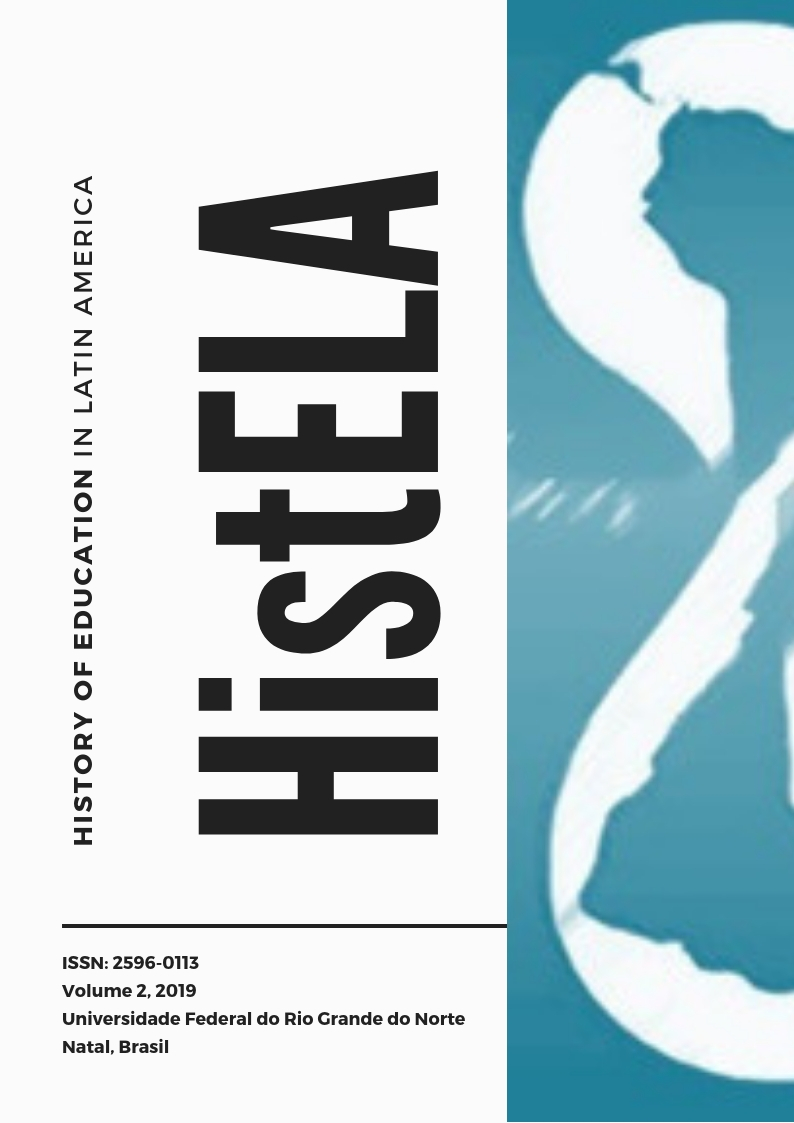A Revista Careta e a instituição de saberes religiosos nos discursos para a educação feminina (1914-1918)
DOI:
https://doi.org/10.21680/2596-0113.2019v2n0ID17295Palabras clave:
Revista Careta, Análise do discursoResumen
Este trabalho trata da educação feminina nos enunciados da revista Careta, com recorte para o saber religioso percebido nos conteúdos em circulação no periódico. A leitura da fonte histórica foi problematizada a partir da análise do discurso proposta por Michel Foucault (2010), motivada pela percepção de um arranjo discursivo constituído por saberes elaborados por diferentes instituições, mas que orquestravam-se no propósito de orientar o comportamento feminino em determinados padrões sociais. Papéis sociais femininos foram colocados em circulação e aqui estão analisados sob a perspectiva de elaborar sobre como os saberes religiosos contribuíram para o regime de verdade de um discurso que se propõe um alcance nas práticas.
Descargas
Citas
Almeida, M. M. (1994). Na trilha de um andarengo: Alcides Maya (1877-1944). Porto Alegre: EDIPUCRS.
Anais da Câmara dos Deputados. (1916). Pronunciamento do Deputado Mauricio de Lacerda. Rio de Janeiro.
ANDRÉ, R. G. (2009). Entre o contexto e a linguagem: O discurso fotográfico e a pesquisa histórica. Domínios da imagem, 3(5), 153-162.
Careta. (1914). Rio de Janeiro: Editora Kosmos.
Careta. (1915). Rio de Janeiro: Editora Kosmos.
Careta. (1916). Rio de Janeiro: Editora Kosmos.
Careta. (1917). Rio de Janeiro: Editora Kosmos.
Careta. (1918). Rio de Janeiro: Editora Kosmos.
D’Incao, M. Â. (1997). Mulher e família burguesa. In L. D Priori (Org.), História das mulheres no Brasil. São Paulo: Contexto.
Federici, S. (2017). Calibã e a bruxa: Mulheres, corpo e acumulação primitiva (Coletivo Sycorax, Trad.). São Paulo: Elefante.
Foucault, M. (1988). História da sexualidade. In M. Foucault. A vontade de saber (M. T. Albuquerque & J. A. G. Albuquerque, Trad.). Rio de Janeiro: Edições Graal.
______. (1991). Vigiar e punir: Nascimento da prisão (38ª ed.). Petrópolis: Vozes.
______. (2005). Em defesa da sociedade: Curso no Collège de France (1975-1976) (M. E. Galvão, Trad.). São Paulo: Martins Fontes.
______. (2010). A ordem do discurso (20ª ed., L. A. Sampaio, Trad.). São Paulo: Edições Loyola.
Maluf, M. & Mott, M. L. (2006). Recônditos do mundo feminino. In N. Sevcenko (Org.), História da vida privada no Brasil 3: República: Da Belle Époque à era do rádio. São Paulo: Companhia das Letras.
Rago, M. (2014). Amores ilícitos na Paris de Émile Zola. Revista História e Perspectivas, (50), 45-88.
Revel, J. (2011). Dicionário Foucault (A. A. Silva, Trad.). Rio de Janeiro: Forense Universitária.
Varikas, E. (2009). Universalismo e particularismo. In H. Hidrata, F. Laborie, H. Le Doaré & D. Senotier (Orgs.), Dicionário Crítico do Feminismo (pp. 266-270). São Paulo: Editora UNESP (FEU).
Volusia, E. (1983). Eu e a dança. Rio de Janeiro: Revista Continente Editorial.
Descargas
Publicado
Cómo citar
Número
Sección
Licencia
Autores que publicam nesta revista concordam com os seguintes termos:
Autores mantém os direitos autorais e concedem à revista o direito de primeira publicação, com o trabalho simultaneamente licenciado sob a Licença Creative Commons — Attribution 4.0 International — CC BY 4.0 que permite o compartilhamento do trabalho com reconhecimento da autoria e publicação inicial nesta revista.
Autores têm autorização para assumir contratos adicionais separadamente, para distribuição não-exclusiva da versão do trabalho publicada nesta revista (ex.: publicar em repositório institucional ou como capítulo de livro), com reconhecimento de autoria e publicação inicial nesta revista.
Autores têm permissão e são estimulados a publicar e distribuir seu trabalho online (ex.: em repositórios institucionais ou na sua página pessoal) a qualquer ponto antes ou durante o processo editorial, já que isso pode gerar alterações produtivas, bem como aumentar o impacto e a citação do trabalho publicado.


 Português (Brasil)
Português (Brasil) English
English Español (España)
Español (España) Français (Canada)
Français (Canada)



